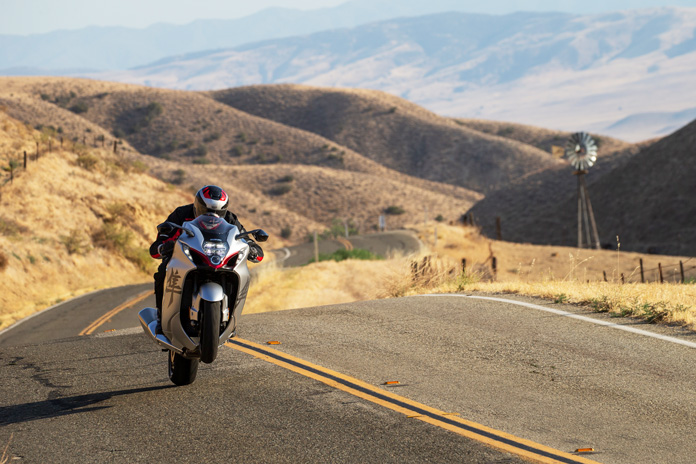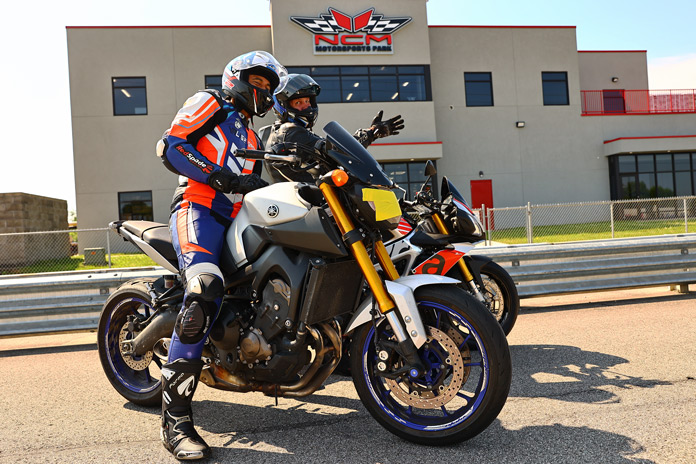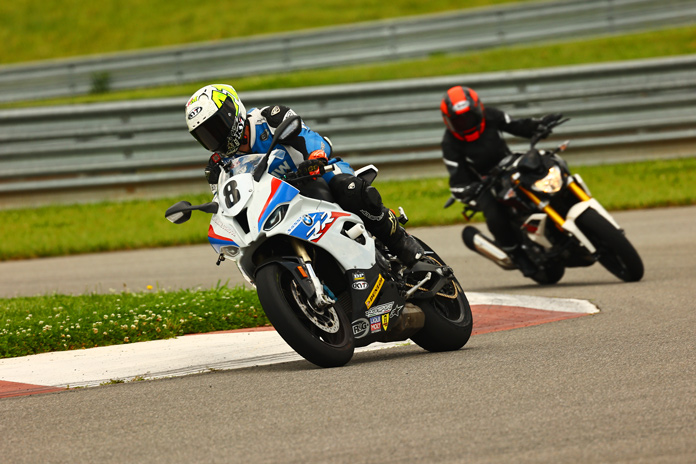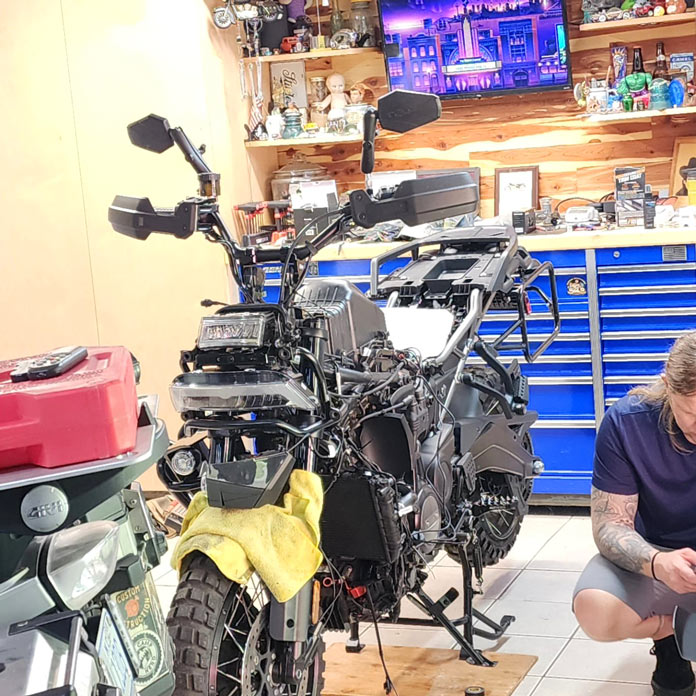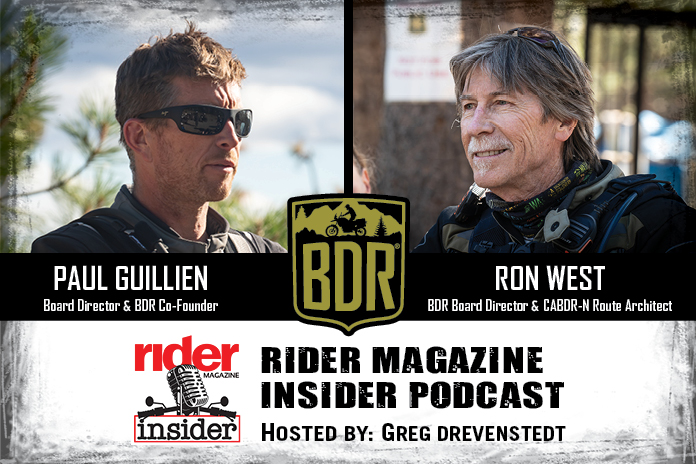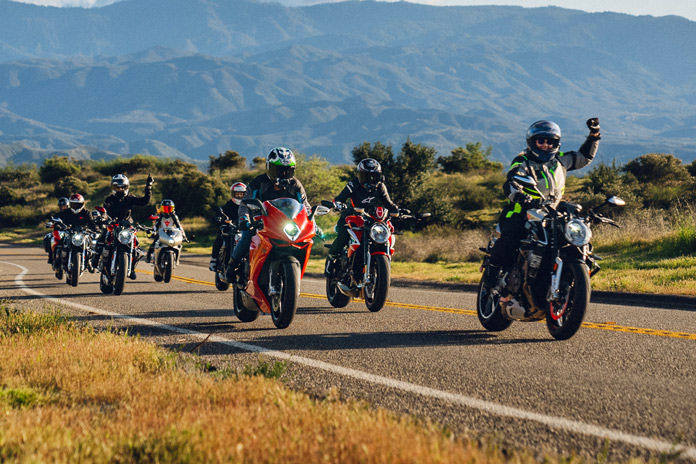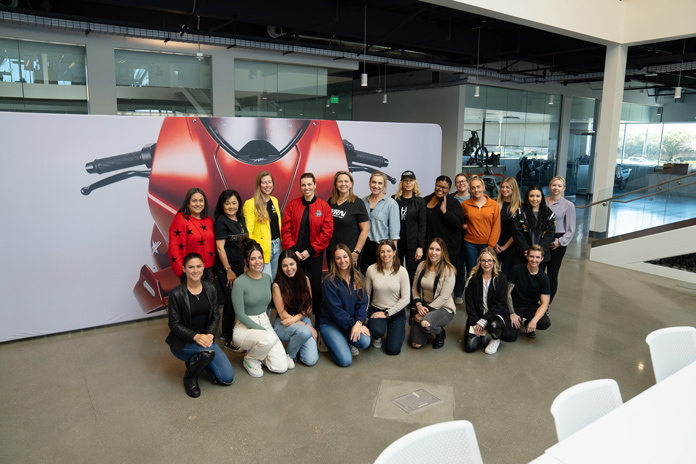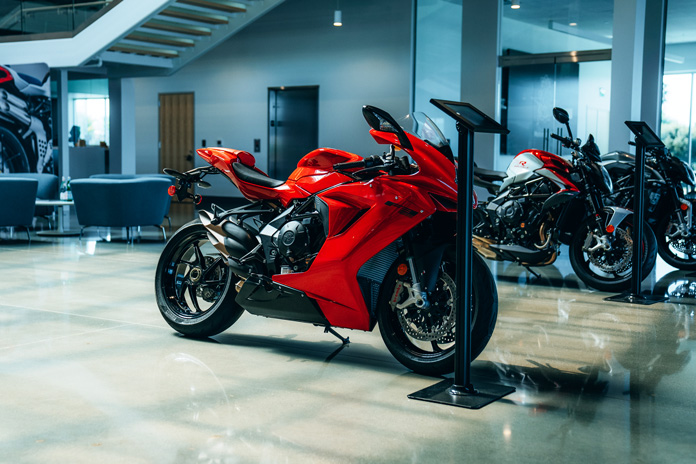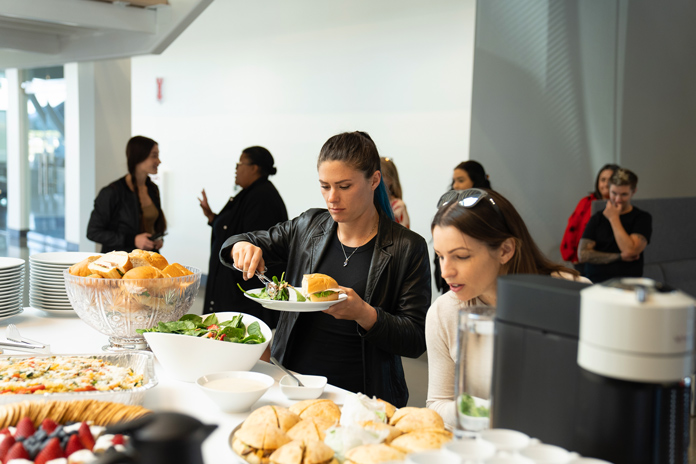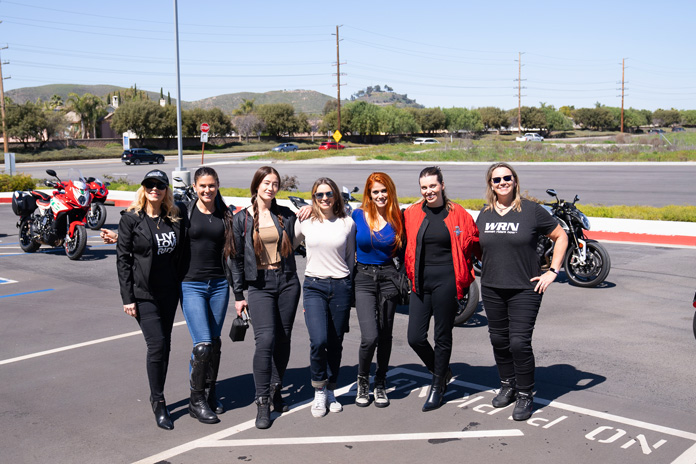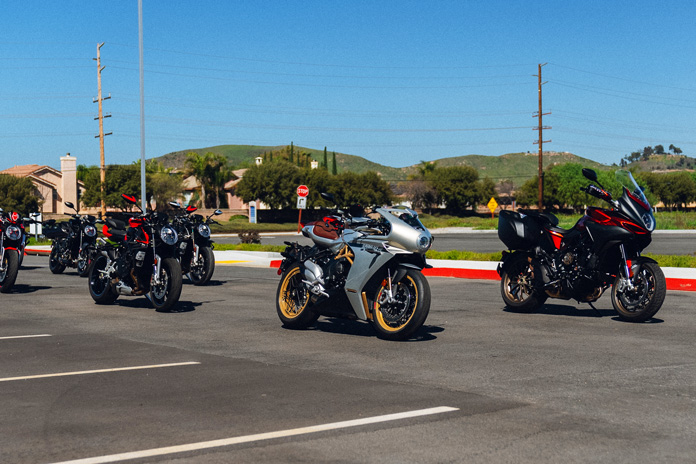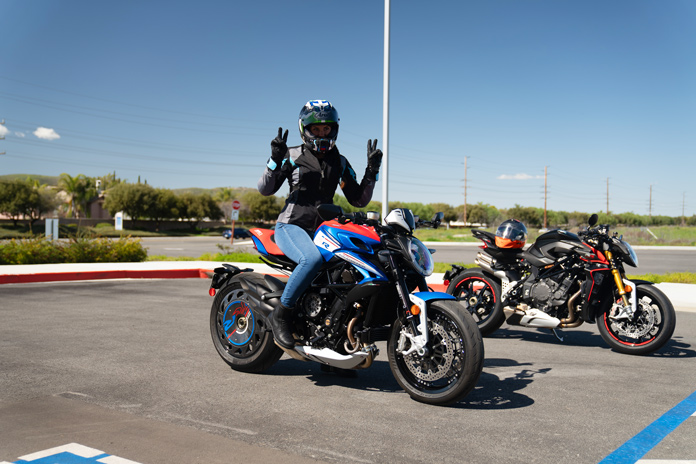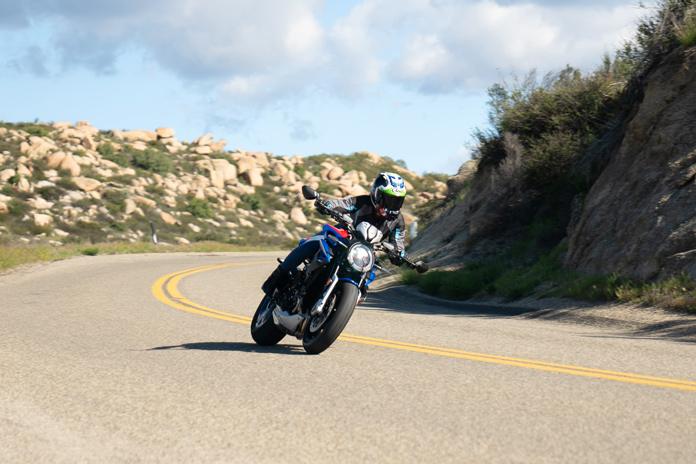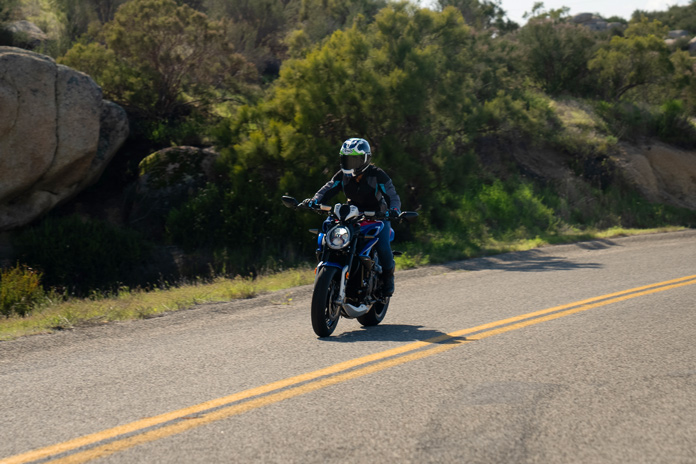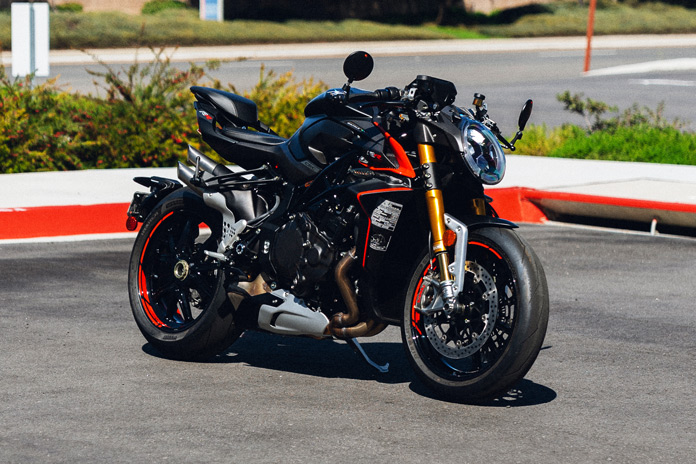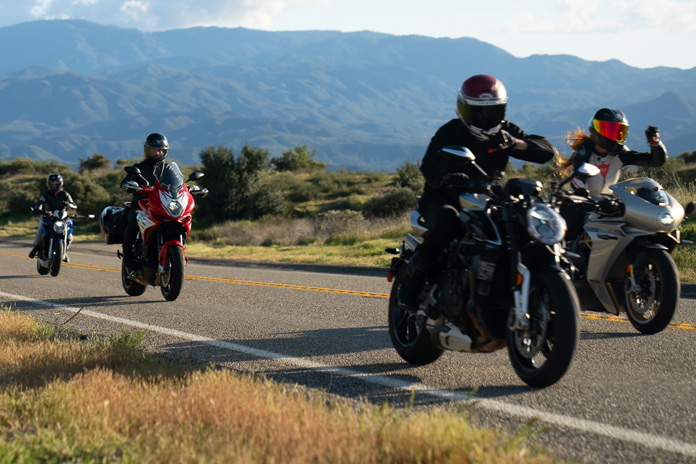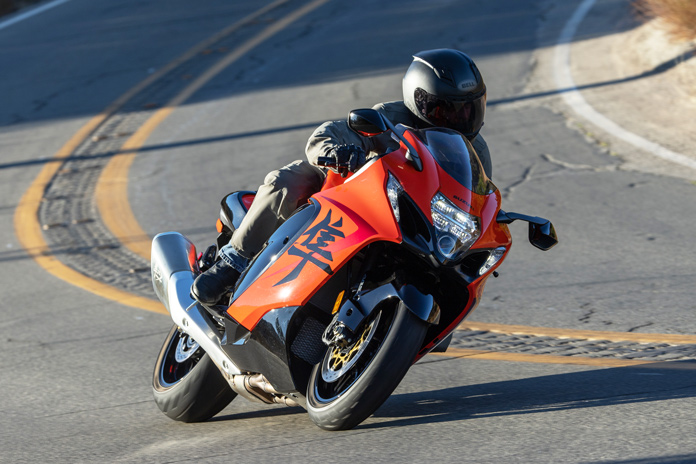
There are countless excellent motorcycles in the world, but there are just a few veritable icons. Of all the Japanese bikes launched in the last 25 years, the Suzuki Hayabusa is perhaps most worthy of icon status.
The sportbike paradigm shifted in 1999 when Suzuki introduced the GSX1300R Hayabusa. It had the most powerful engine in a production motorcycle and aerodynamic bodywork that looked like nothing else on the road.
For a quarter century, the Hayabusa has defined what an ultra-fast motorcycle should be. More than 200,000 Busas have found their way into the hands of speed-addled enthusiasts, from lightning-quick dragracers to sport-touring mavens who strap on luggage and blaze highways at blurring speeds.
Fast Design | Suzuki Hayabusa
There’s always been a need for speed, and velocities ramped up in 1990 with the introduction of Kawasaki’s ZX-11, which could exceed 170 mph. Honda retaliated in 1996 with its CBR1100XX Super Blackbird, which could hit 174 mph.

Suzuki wanted in on this high-speed action and began developing a monumental motorcycle, with the goal of being “the most powerful production bike in the world, but at the same time have usable, rider-friendly performance.” We weren’t quite prepared for the groundbreaking machine that emerged from Suzuki’s drawing boards.
Big speed requires keen attention to aerodynamics, so Suzuki’s new flagship would need to slip cleanly through the air to become the king of speed. The fastest animal in the world is the peregrine falcon, a bird renowned for its ability to hit 200 mph during a steep dive.

The Japanese word for the falcon is “hayabusa,” and the kanji character for the word was emblazoned on the bike. Peregrine falcons sometimes eat blackbirds for lunch, and so would the motorcycle that shares its Japanese name.
At the bike’s launch in 1999, Suzuki proclaimed class-leading aero. The Busa’s bullet-shaped nose featured a stacked headlight arrangement to narrow the bike’s frontal area. The front turnsignals were integrated into the nose to help funnel air to the pressurized airbox to boost power at high speeds.

The Busa’s chassis was more conventional: a twin-spar aluminum frame with an inverted fork and a monoshock, both fully adjustable. Offsetting the bike’s 550-lb curb weight was a 24.2-degree rake (the steepest in the category) and a mere 3.9 inches of trail. A 58.5-inch wheelbase and a steering damper helped provide high-speed stability. The front brakes featured 6-piston Tokico calipers biting on 320mm discs.
Fast and Furious | Suzuki Hayabusa
Suzuki used lessons learned in developing its GSX-R motors, using 81mm forged-aluminum pistons reciprocating over a 63mm stroke to yield 1,299cc. The Busa also featured fuel injection, a novelty in that era, and an air injection system minimized emissions without hurting performance. A 4-2-1-2 exhaust included a catalytic converter to keep it EPA-legal. A gear-driven counterbalancer reduced vibration.

Suzuki blew us away with an unprecedented 173 crankshaft horsepower. That number dwarfed the GSX-R1100W’s output by 20 horses and easily outgunned Honda’s Blackbird. Put it all together, and the Busa was able to reach an astounding 194 mph when tested by Cycle World.

I got my first crack at the Busa in 1999 and was thrust into hyperspace. “It’s mind-bendingly fast,” I wrote, “and the explosions inside the engine feel like little sticks of dynamite are being fed through the intake valves, igniting the mixture with greater force than what had been considered possible from a production streetbike.”

During dyno testing, the motor piled on at least 20 hp every 1,000 rpm from 2,500 to 7,500 rpm! Additionally, it generated 73 lb-ft at just 2,500 rpm, the same torque as Yamaha’s 1999 YZF-R1 made at its peak. Describing the Busa as “fast” is like calling the Sistine Chapel “pretty.”
Also impressive was the bike’s finish quality, which exceeded most other Suzukis of the era. Its 10-disc back-torque limiting slipper clutch was stout, and its 6-speed gearbox shifted precisely.

Fast Limit | Suzuki Hayabusa
Kawasaki didn’t like Suzuki stealing the top-speed throne and retaliated in 2000 with the 178-hp ZX-12R. Surprisingly, it could only reach a top speed of 186 mph. That’s when we learned that manufacturers had voluntarily agreed to an arbitrary speed limit of 300 kph (186 mph) to avoid potential regulations on sportbikes. The top-speed wars ended by unofficial decree.
Meanwhile, the Hayabusa kept on rolling as the poster child for motorcycle excess. Wild custom paint jobs covered the Busa’s distinctive bodywork, turbos and nitrous kits were added, and extended swingarms with fat tires became all the rage.
But it wasn’t just sportbike jockeys who appreciated the Hayabusa’s effortless speed. Travelers who needed to get to faraway places in a hurry often chose Busas as sport-touring rigs, creating the hypersport-touring niche.
The Busa’s rivals were vastly overshadowed by its massive impact on this market – more than 115,000 Gen 1s were sold. The Blackbird’s run ended in 2002. Kawasaki revamped its 1,198cc ZX-12R in 2002, but it wasn’t able to elbow its way into the Busa’s dominance among speed freaks.
Fast Reignition: Gen 2 | Suzuki Hayabusa
Kawasaki killed off the 12R and replaced it in 2006 with the ZX-14. It was a worthy challenger but lacked the Busa’s rowdiness and street cred. The slugfest escalated in 2008 when Kawasaki introduced the ZX-14R and Suzuki gave the Busa its first significant makeover.
Related: 2008 Suzuki Hayabusa vs. Kawasaki ZX-14 – Comparison Review
The engine’s displacement was bumped to 1,340cc by increasing its stroke 2mm. Lighter and stronger forged pistons bumped compression up to 12.5:1, and a forged crank spun chromoly rods shot-peened for extra strength. Up top were 16 titanium valves, and new camshafts offered greater lift and revised timing. Cam-chain tension was switched over to a hydraulic system.
Suzuki claimed a 12% improvement in horsepower, stretching to 194 hp at the crankshaft, a 21-horse boost. Torque was bumped 8.5% to 114 lb-ft. Harnessing the bigger power was a revised clutch that offered better feedback and employed the Suzuki Clutch Assist System.
Modest chassis tweaks included fork sliders with a DLC coating to minimize stiction, a stiffer swingarm, and upgraded Brembo 4-piston radial calipers. Refreshed bodywork featured smoother body panel joints with hidden fasteners and a tailsection with integrated turnsignals that were said to evoke a jet-engine exhaust.
The bike looked sharper and more modern without losing its distinctive appearance, but it was saddled with a pair of ungainly triangular mufflers – a product of new emissions standards. Curb weight went up by 7 lb, and so did sales of aftermarket exhaust systems.
Ergonomic tweaks consisted of a lower fuel tank so riders could better tuck behind the taller windscreen and a lowered rear subframe with a plusher rear seat. The tailsection included attachment points for securing luggage, and the area under the solo-seat hump offered additional storage.
The revised Busa was faster, handled better, and stopped with more authority, and it offered steering that was more neutral and direct than the formidable ZX-14R. As usual, the Busa impressed with its effortless power output. In Rider’s 2008 comparison test, Bill Stermer quipped: “Being in a dither about whether they make more power is like wondering if Jennifer Lopez would be more attractive if she parted her hair differently.”
Fast Money | Suzuki Hayabusa
Motorcycle sales had been on an unprecedented upward surge during the 2000s. Hayabusas were soaring off showroom floors, and aftermarket support was robust.

But then the Great Recession hit, and motorcycle sales dropped by more than half almost overnight. The battles for hyperbike supremacy took a hiatus until 2012 when Kawi unveiled a new ZX-14R, which packed 1,441cc of heat that trumped the Busa on the dyno by 17 hp. But the Suzuki was 11 lb lighter and was able to give its rival a run for the money. I logged a blistering 9.8-second E.T. on the Busa at the dragstrip, just a tenth behind the Kawi.
As recessionary forces continued to depress the moto market, the colorful hyperbike scene faded.
Fast Gen 3 | Suzuki Hayabusa
The Busa’s third generation was introduced in May 2021 and labeled “The Refined Beast.” Billed as a 2022 model, it received a styling update yet was unmistakably a Hayabusa. Suzuki slathered its new hyperbike with the latest technology and priced it at $18,599.
Related: 2022 Suzuki Hayabusa | Road Test Review
Never before could you get a Busa with TFT instrumentation, cruise control, a bi-directional quickshifter, or traction control, but those all became standard equipment. Brakes got an upgrade with the addition of Brembo’s vaunted Stylema calipers paired with 320mm discs and cornering ABS. The Busa’s IMU-based electronics package includes six riding modes and adjustable traction control, engine braking, and wheelie control, along with launch control and hill-hold control.
In homage to the original, the new Busa’s instrument panel includes analog gauges that, as in 1999, use stepper motors to ratchet up the needles to their max values when the ignition is switched on. A small TFT display sits in the center.
The engine architecture and displacement carried over into Gen 3, but most internal components were lightened, strengthened, or refined for less friction. Cam profiles were revised to reduce valve lift overlap and help achieve Euro 5 emissions standards. A new exhaust system shaved 4.5 lb, bringing the bike’s curb weight to 582 lb.
Suzuki rates the 1,340cc inline-Four at 188 hp, down 6 ponies from previous but with additional low- and midrange power. When we tested the Busa on Jett Tuning’s dyno, it generated a vigorous 173 hp and 106 lb-ft of torque at its rear tire.
Fast 25 | Suzuki Hayabusa
It’s exceedingly rare when a motorcycle model endures for a quarter century, so Suzuki celebrated the milestone with a special 25th Anniversary Edition Hayabusa in 2024. It features a special Glass Blaze Orange / Glass Sparkle Black paint scheme, a 25th-anniversary emblem atop the fuel tank, and anniversary logos etched on each muffler.

I had the honor of putting some miles on one and revisiting the majesty of the venerable Busa. As usual, the engine is so omnipotent that it makes the numbers on the speedo seem like they’re in kilometers per hour rather than mph. Traveling at 100 mph is absolutely effortless, so riders need to keep a watchful eye on the speedo or risk running afoul of speed limits. First gear alone will take you to 85 mph.
The bike exhibits confident and stable handling, and the stiff chassis responds immediately without any flex. The KYB suspension is well-dialed, and the 31.5-inch seat retains the cushiness of previous Busas, but there’s not much room between the saddle and the high footpegs. The reach for the bars is relatively long, but the fairing offers excellent wind protection for a sportbike. Its 5.3-gallon tank offers a touring-worthy 200 miles of range.
Fast Legacy | Suzuki Hayabusa
The Hayabusa’s 25-year run proves that nothing exceeds like excess. The Busa’s legendary lump of an engine continues to thrill riders today, and it has proven to be almost unkillable – some owners have racked up six-figure mileage on the odometer.
But the Busa is more than just one of the fastest earth-bound missiles ever created. Its bulbous and smooth styling, which previously looked almost cartoonish, has become a staple of sportbike design and continues to impress passersby. While the Hayabusa is overkill for tight twisty roads, its cocktail of speed and style makes for high levels of excitement on wide-open asphalt from coast to coast.
We are wary of using the term “icon” to describe a motorcycle, but the word certainly fits when it comes to Suzuki’s incredible Hayabusa. The king still reigns.
The post Suzuki Hayabusa, 1999-2024: Your Majesty for 25 Years appeared first on Rider Magazine.
Source: RiderMagazine.com

